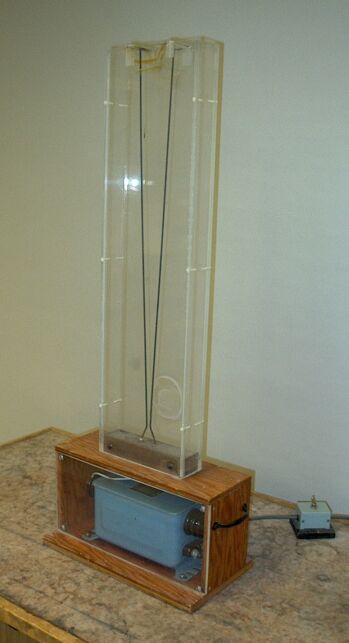
A video of this demonstration is available at this link.
This is a favorite in horror movies or films involving “mad scientists” and the like. The two wires are 30 inches long, and they are bent so that the gap at the bottom is just under one centimeter (~7 mm) and the distance at the top is about 7 centimeters. The wires are connected to the output of a luminous tube transformer, whose secondary provides 15,000 volts. (This is an effective value, the rms (root-mean-square), so the peak voltage is about 21,000 volts.) When you plug the apparatus in and turn it on, an arc forms at the bottom, then rises along the wires until it reaches the top. When this happens, the arc ceases, and a new one forms at the bottom, beginning the process again. The arc makes a nice sizzling sound as it rises, and a snap as it goes out at the top.
What is happening?
Breakdown voltage, that is, the minimum potential difference between two electrodes at which the air between them becomes conductive, depends on air pressure, humidity, the distance between the electrodes and the shape of the electrodes. For the wire electrodes in this apparatus, the 21,000-volt peak voltage of the transformer secondary is enough to cause breakdown at the sharp bends near the bottom of the electrodes, where they are closest together. Because of background radioactivity and occasional cosmic rays, there are normally some electrons and positive ions in the air, which are accelerated if they are in the electric field between two electrodes. If an electron thus accelerated can attain enough energy within its mean free path, it ionizes the next air molecule with which it collides. The electron the air molecule loses is similarly accelerated, and it ionizes yet another molecule. The (positively charged) ions thus formed are accelerated in the opposite direction to the electrons and collisionally excite, and undergo charge exchange with, other air molecules. A conductive path thus forms between the two electrodes, and an arc jumps the gap between them. In this arc are excited neutral molecules, ions and electrons. In relaxing to lower-energy states, the excited molecules emit light, which we see as a glow or spark between the two electrodes. Once an arc forms, the voltage necessary to sustain it is considerably less than the breakdown voltage. For each half cycle of the transformer output, the time for which the potential difference between the electrodes is below this voltage is short enough that the arc does not go out, but is sustained.
Because of the increased number and energy of the collisions in the arc, relative to those in the surrounding air, the air within the arc heats up. As it does so, it expands and becomes less dense than the surrounding air. The buoyant force on it thus exceeds that of gravity, and the arc rises. The wires get farther and farther apart as they near the top of the apparatus, but the voltage necessary to sustain the arc as it travels up the wires is less than the initial breakdown voltage, and the arc continues until it reaches the ends of the wires. At this point, it rises until the gap is too wide for the arc to be sustained, and it goes out. When this happens, another arc forms at the sharp bends near the bottom of the electrodes, and the process begins again. (Sometimes, the air does not heat evenly, and one end of the arc rises faster than the other. The path of the arc thus becomes sufficiently long that the transformer voltage cannot sustain it, and it goes out before it reaches the top of the electrrodes. Another subtlety is that because of the current-voltage characteristics of the arc, and because the transformer provides some current, once breakdown occurs, the voltage across the electrodes drops. When the arc goes out, the voltage rises again to its original value. This is why a new arc does not form at the bottom until the previous arc has gone out.)